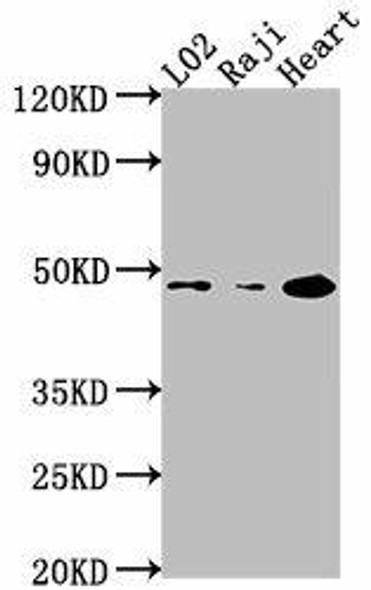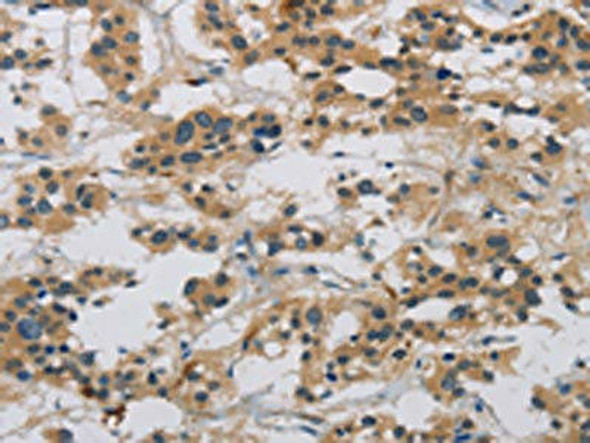CASP9 Antibody (PACO05505)
- SKU:
- PACO05505
- Product type:
- Antibody
- Reactivity:
- Human
- Monkey
- Host Species:
- Rabbit
- Isotype:
- IgG
- Application:
- ELISA
- Application:
- WB
- Application:
- IHC
- Application:
- IF
- Antibody type:
- Polyclonal
- Conjugation:
- Unconjugated
Frequently bought together:
Description
| Antibody Name: | CASP9 Antibody (PACO05505) |
| Antibody SKU: | PACO05505 |
| Size: | 50ug |
| Host Species: | Rabbit |
| Tested Applications: | ELISA, WB, IHC, IF |
| Recommended Dilutions: | ELISA:1:5000, WB:1:500-1:2000, IHC:1:100-1:300, IF:1:200-1:1000 |
| Species Reactivity: | Human, Monkey |
| Immunogen: | Synthesized peptide derived from human Caspase-9 around the non-phosphorylation site of Y153. |
| Form: | Liquid |
| Storage Buffer: | Liquid in PBS containing 50% glycerol, 0.5% BSA and 0.02% sodium azide. |
| Purification Method: | The antibody was affinity-purified from rabbit antiserum by affinity-chromatography using epitope-specific immunogen. |
| Clonality: | Polyclonal |
| Isotype: | IgG |
| Conjugate: | Non-conjugated |
| Synonyms: | CASP9; MCH6; Caspase-9; CASP-9; Apoptotic protease Mch-6; Apoptotic protease-activating factor 3; APAF-3; ICE-like apoptotic protease 6; ICE-LAP6 |
| UniProt Protein Function: | CASP9: a member of the cysteine-aspartic acid protease (caspase) family. Sequential activation of caspases plays a central role in the execution-phase of cell apoptosis. Caspases exist as inactive proenzymes which undergo proteolytic processing at conserved aspartic residues to produce 2 subunits, large and small, that dimerize to form the active enzyme. This protein is processed by caspase APAF1; this step is thought to be one of the earliest in the caspase activation cascade. Alternative splicing results in two isoforms. |
| UniProt Protein Details: | Protein type:Apoptosis; EC 3.4.22.62; Protease Chromosomal Location of Human Ortholog: 1p36.21 Cellular Component: apoptosome; cytosol Molecular Function:cysteine-type endopeptidase activity; enzyme activator activity; peptidase activity; protein binding; protein kinase binding; SH3 domain binding Biological Process: apoptosis; caspase activation via cytochrome c; DNA damage response, signal transduction; DNA damage response, signal transduction resulting in induction of apoptosis; platelet formation; response to DNA damage stimulus |
| NCBI Summary: | This gene encodes a member of the cysteine-aspartic acid protease (caspase) family. Sequential activation of caspases plays a central role in the execution-phase of cell apoptosis. Caspases exist as inactive proenzymes which undergo proteolytic processing at conserved aspartic residues to produce two subunits, large and small, that dimerize to form the active enzyme. This protein can undergo autoproteolytic processing and activation by the apoptosome, a protein complex of cytochrome c and the apoptotic peptidase activating factor 1; this step is thought to be one of the earliest in the caspase activation cascade. This protein is thought to play a central role in apoptosis and to be a tumor suppressor. Alternative splicing results in multiple transcript variants. [provided by RefSeq, May 2013] |
| UniProt Code: | P55211 |
| NCBI GenInfo Identifier: | 28558771 |
| NCBI Gene ID: | 842 |
| NCBI Accession: | P55211.3 |
| UniProt Secondary Accession: | P55211,O95348, Q53Y70, Q5JRU9, Q5UGI1, Q92852, Q9BQ62 Q9UEQ3, Q9UIJ8, B4E1A3, |
| UniProt Related Accession: | P55211 |
| Molecular Weight: | |
| NCBI Full Name: | Caspase-9 |
| NCBI Synonym Full Names: | caspase 9 |
| NCBI Official Symbol: | CASP9 |
| NCBI Official Synonym Symbols: | MCH6; APAF3; APAF-3; PPP1R56; ICE-LAP6 |
| NCBI Protein Information: | caspase-9 |
| UniProt Protein Name: | Caspase-9 |
| UniProt Synonym Protein Names: | Apoptotic protease Mch-6; Apoptotic protease-activating factor 3; APAF-3 |
| Protein Family: | Caspase |
| UniProt Gene Name: | CASP9 |










